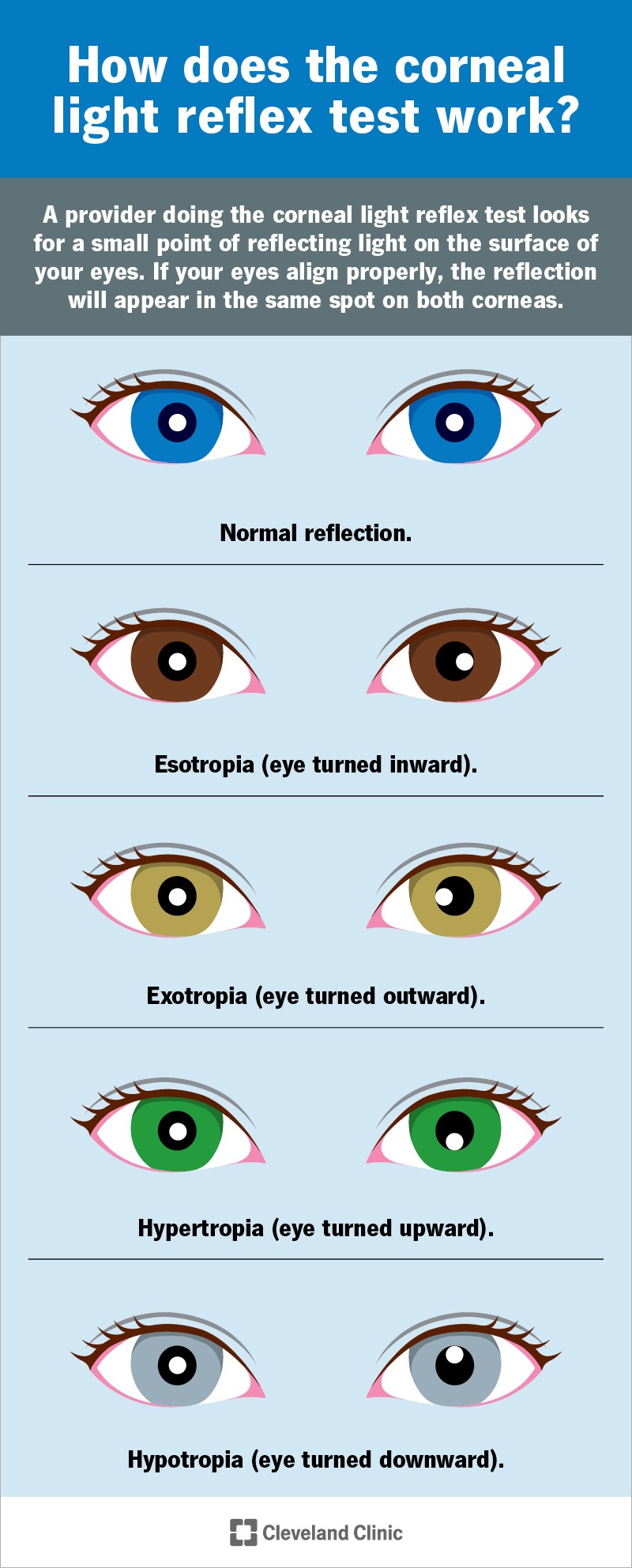The corneal light reflex test is a tool healthcare providers and eye care specialists use to check your eye alignment. The position of light reflecting off your eye surface is a useful way to tell if your eyes line up correctly. It’s a key tool to screen for and diagnose eye conditions, and several brain-related issues, too.
Advertisement
Cleveland Clinic is a non-profit academic medical center. Advertising on our site helps support our mission. We do not endorse non-Cleveland Clinic products or services. Policy

The corneal light reflex test lets healthcare providers check your eye alignment using light reflecting on your corneas. All it takes is a dim room and a penlight or similar tool. It’s also known as the Hirschberg test, after its creator, German ophthalmologist Julius Hirschberg. This test is simple, painless and takes just a moment or two.
Advertisement
Cleveland Clinic is a non-profit academic medical center. Advertising on our site helps support our mission. We do not endorse non-Cleveland Clinic products or services. Policy
The corneal light reflex test is extremely common in a few different settings:
A healthcare provider doing the Hirschberg test looks for a small point of reflecting light on the surface of your eyes. If your eyes align properly, the reflection will appear in the same spot on both corneas.
Before a provider or eye specialist does the corneal light reflex test, they’ll dim the lights in the room. That makes it easier for them to see the reflection on your corneas. Once the lights are dim, your provider will sit in front of and facing you with a small light in their hand. They’ll have you look at the light. While you do, they’ll look closely at your eyes to see the positioning of the reflection.
After the test, your provider will do one of two things, depending on what they find:
Advertisement
Your healthcare provider can tell you whether or not they see a misalignment during or right after the test. They can also talk you through related tests and measurements that they use to confirm if you have a misalignment and measure the size of it.
If your eyes have normal alignment, your provider will record that using either “symmetry” or “ortho” on your record. “Symmetry” means the reflection positions match on both eyes. “Ortho” comes from the ancient Greek word meaning “straight.”
One reason providers confirm misalignments is a condition called pseudostrabismus. That’s when something makes you look like you have a misalignment even though you don’t. It’s possible when you have certain facial features like epicanthal folds (monolid eyes). It can also happen with certain differences in your facial structure or when the distance between the center of your pupil and nose (pupillary distance) isn’t the same on both sides.
If your provider confirms your eyes don’t align properly, they’ll record what kind of misalignment it is. Examples include:
If a pediatrician or primary care provider finds that you have (or a child you care for has) an eye misalignment, they’ll refer you to an ophthalmologist. Ophthalmologists can determine what’s causing your misalignment and recommend treatment options.
Providers like neurologists can use the corneal light reflex to check for brain-related issues. Examples include strokes or concussions. The next steps and treatment for these depend strongly on the underlying cause and other factors. In those situations, your provider can tell you what to expect next in your specific case.
Gradual misalignments may be hard to see at first. If you think you see an eye misalignment in a child you care for, call their pediatrician and ask for an appointment. Conditions like amblyopia (lazy eye) are treatable in early childhood. But past a certain age, they cause permanent vision loss, so it’s best not to delay diagnosis and treatment. In adults, gradual misalignments mean you should schedule an appointment with an eye care specialist.
When a noticeable eye misalignment happens suddenly (over a span of minutes or hours), it’s a medical emergency and needs immediate care. That’s especially true after a head injury or with any warning signs of a stroke. In these cases, call 911 (or your local emergency services number) immediately.
Advertisement
The light in your eyes isn’t just a topic for love songs and poetry. Light reflecting on your eye surface is also a way for medical professionals to check your eye alignment. The corneal light reflex (Hirschberg) test is helpful for children and adults alike. Better still, it’s quick and painless. If you have any questions about this test or your eye alignment, talk to a healthcare provider or an eye care specialist. They can tell you more about the test and help address any concerns you have about it.
Advertisement
Getting an annual eye exam at Cleveland Clinic can help you catch vision problems early and keep your eyes healthy for years to come.

Last reviewed on 04/14/2025.
Learn more about the Health Library and our editorial process.